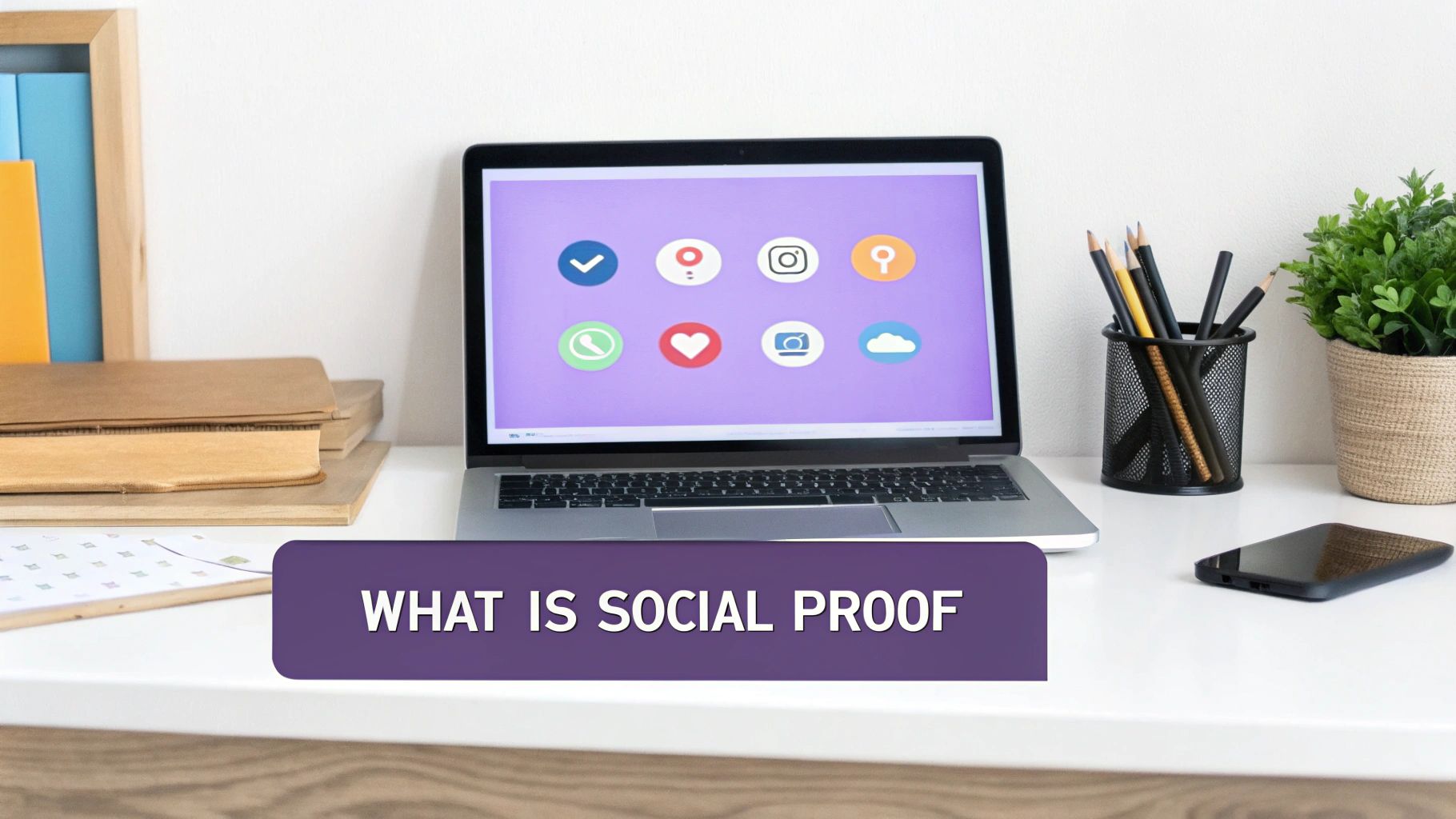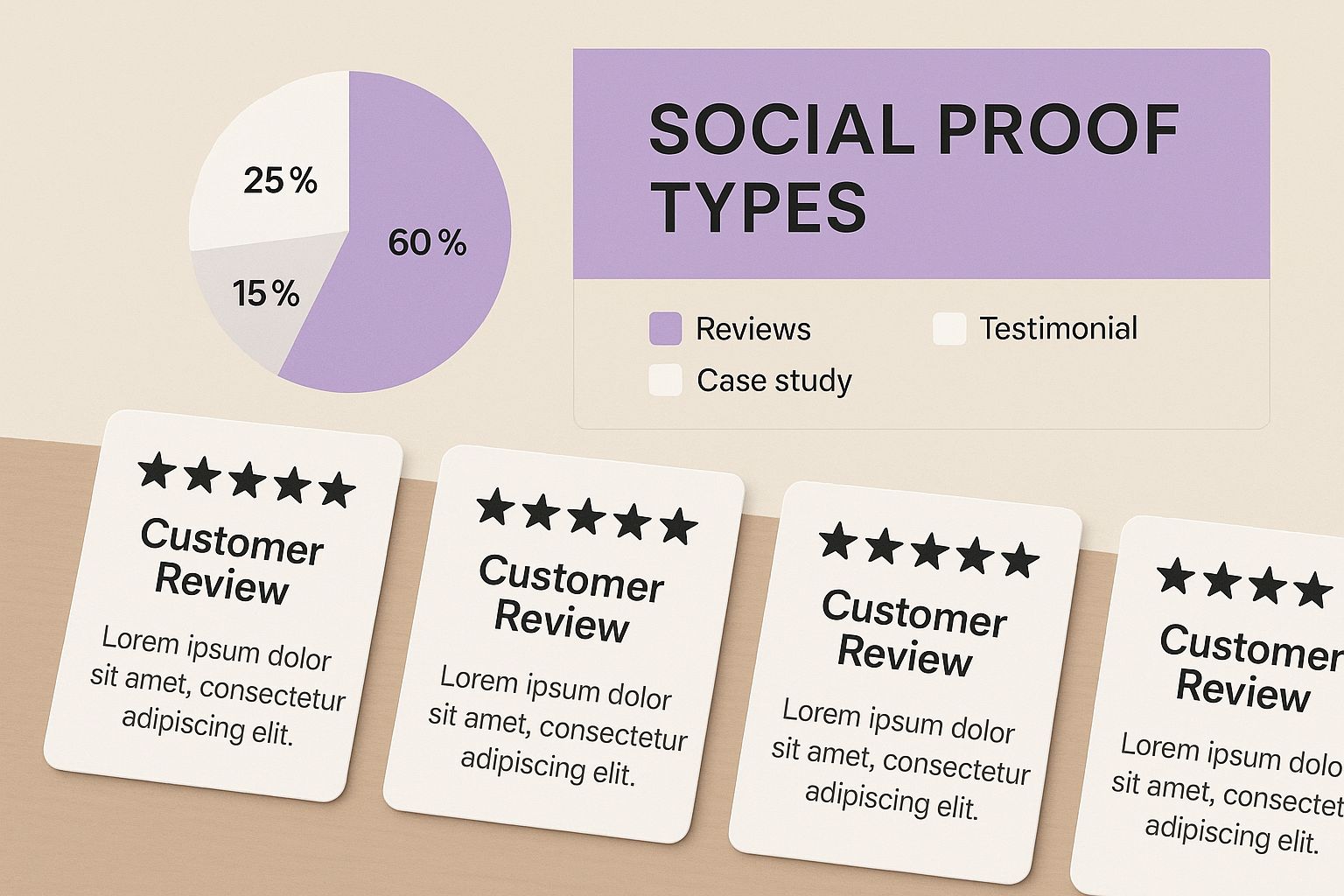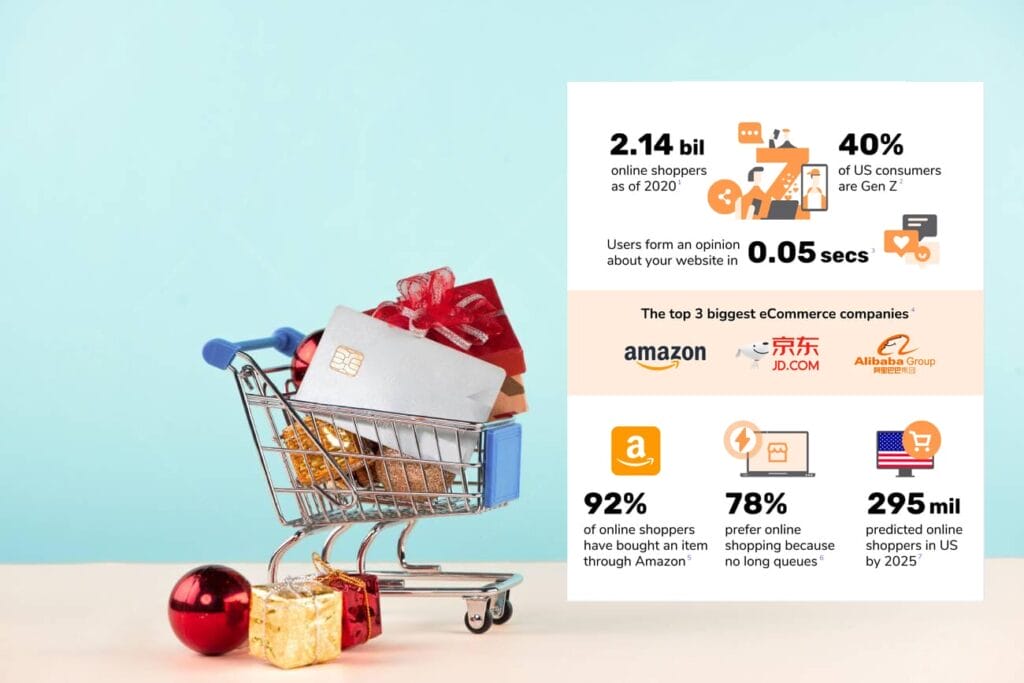The Psychology Behind Effective Marketing Social Proof
Why does a bustling restaurant draw us in, while a quiet one leaves us hesitant? Why do thousands of five-star reviews convince us to click “buy,” even for a product we’ve never seen in person? The answer lies in the psychology of marketing social proof. As social creatures, we’re wired to be influenced by the actions and opinions of others, especially when we feel uncertain. This tendency is deeply rooted in several core psychological principles.

Conformity and the Herd Mentality
One of these principles is conformity bias, sometimes called the herd mentality. This describes our innate tendency to follow the crowd. We often assume that if many people are doing something, it must be the right choice. Imagine a software product with hundreds of glowing testimonials from satisfied customers. We’re naturally inclined to see it as reliable and worthwhile, particularly if we’re not tech-savvy ourselves.
Risk Aversion and the Fear of Missing Out
Another powerful driver is risk aversion. We’re programmed to avoid losses and seek safety. Social proof provides that sense of security. Positive reviews and testimonials act like a safety net, assuring us that others have had good experiences and we’re less likely to be disappointed. This ties into our Fear of Missing Out (FOMO). A limited-time offer, combined with social proof suggesting high demand, creates a sense of urgency. Suddenly, we’re motivated to act quickly before the opportunity vanishes, a tactic particularly effective for limited edition products or services.
Authority and the Power of Experts
The opinions of authority figures also carry significant weight. We’re more likely to trust experts and those we see as knowledgeable. This explains the persuasive power of endorsements from industry leaders or celebrities. These figures often have established credibility and influence, making us more receptive to their recommendations. In today’s marketing world, this translates to influencer collaborations, where the trust an influencer has built with their audience transfers to the endorsed product.
The impact of social proof is clearly demonstrated by the influence of customer reviews on purchasing decisions. Displaying customer reviews can boost purchases by as much as 67%. Consumers rely heavily on these reviews to make informed choices. A product with five or more reviews is 270% more likely to be purchased than a product with no reviews. Furthermore, 92% of online shoppers hesitate to buy if there are no customer reviews, highlighting the crucial role of social proof in building trust and driving sales. For a deeper dive into these statistics, check out this resource: Learn more about social proof statistics

From Word-of-Mouth to Digital Signals
Social proof has evolved from traditional word-of-mouth recommendations to a complex network of digital signals. These include online reviews, testimonials, social media shares, and influencer endorsements. Brands leverage these signals to build trust, reduce purchase hesitation, and ultimately, drive conversions. Understanding the underlying psychological principles is key to creating effective marketing strategies that resonate with consumers and cultivate a strong brand reputation.
Choosing the Right Social Proof Types for Your Audience
Not all social proof marketing tactics work the same way for every audience. What might convince a Gen Z customer could fall flat with a Baby Boomer. Knowing your target demographic is key to picking the right social proof strategies. For example, younger audiences, used to visual content, might respond well to video testimonials. Older generations, however, might find written reviews more persuasive. This highlights the need to tailor your approach for maximum effect.
Matching Social Proof to Demographics and Buying Stages
Different types of social proof work best at different points in the customer journey. Early on, when someone is just learning about your brand, showing off expert endorsements or industry awards can build initial trust. The social proof of influencers article explains how influencers themselves use social proof, offering insights you can apply to your own marketing strategies. As customers get closer to buying, customer testimonials and reviews become more important. These genuine opinions offer reassurance and address any hesitations.

This image shows various types of social proof, represented by review cards. It emphasizes the importance of considering different formats when planning your social proof marketing strategy. The key takeaway: a varied approach, using multiple social proof types, can effectively reach different parts of your audience.
Leveraging Influencer Marketing and Generational Nuances
Influencer endorsements are a powerful form of social proof, especially for younger demographics. 49% of consumers rely on influencer recommendations, with 61% trusting these recommendations as much as those from family and friends. A significant 32% of Gen Zers have bought products based on influencer endorsements, versus only 9% of Baby Boomers. This shows how vital it is to understand generational differences when using influencer marketing as social proof. More detailed statistics can be found here.
The following table provides a general overview of how different generations respond to various types of social proof. It’s important to remember these are generalizations and individual responses can vary.
Effectiveness of Different Social Proof Types by Generation
| Social Proof Type | Gen Z | Millennials | Gen X | Baby Boomers |
|---|---|---|---|---|
| Influencer Endorsements | High | High | Medium | Low |
| Expert Reviews | Medium | High | High | Medium |
| Customer Testimonials | Medium | High | High | Medium |
| User-Generated Content | High | Medium | Low | Low |
| Online Reviews | High | High | Medium | Low |
| Awards & Recognition | Medium | Medium | High | High |
As this table demonstrates, understanding generational preferences is essential for crafting effective marketing campaigns. While Gen Z might be heavily influenced by influencers and user-generated content, Baby Boomers are more likely to value expert reviews and awards.
Testing and Refining Your Social Proof Strategy
Finding the best mix of social proof for your audience requires experimentation. A/B testing different formats, placements, and messaging helps you discover what truly connects. This data-driven method lets you constantly improve your strategy and maximize the impact of your social proof marketing. By analyzing conversion data and doing user research, you can identify the most effective social proof types at each stage of the customer journey. This ongoing process ensures your social proof strategy stays relevant to your audience’s changing needs and preferences.
Crafting Reviews That Actually Drive Conversions

Customer reviews are more than just feedback; they’re powerful marketing social proof. Instead of passively collecting them, think of reviews as active marketing assets that can significantly boost your conversions. This shift requires a strategic approach, from how you ask for reviews to how you display them on your website.
Soliciting High-Impact Reviews
Getting high-quality reviews is the first step in leveraging marketing social proof. Timing is everything. Asking for feedback immediately after a positive experience, like a successful purchase or a resolved customer service interaction, dramatically increases the chances of a positive review.
How you frame your questions also matters. Instead of a simple “Are you satisfied?”, encourage detailed feedback by asking about specific aspects of the customer experience. For example, asking “How did our product help you achieve your goals?” leads to more insightful and persuasive testimonials.
Following up is key. A gentle reminder a few days later can significantly improve your response rate. A small incentive, such as a discount on their next purchase, can also encourage customers to share their experiences. However, maintain authenticity. Clearly state that incentives are offered regardless of the review’s sentiment. This transparency builds trust with potential customers.
Showcasing Social Proof Strategically
Once you have compelling reviews, showcasing them effectively is the next step. Consider the customer journey. During the consideration phase, highlighting expert reviews or industry awards can build initial credibility. As potential customers move closer to a purchase, feature customer testimonials that address their specific needs and concerns.
Don’t scatter reviews randomly. Strategic placement maximizes their impact. Feature glowing testimonials near call-to-action buttons or on product pages to encourage hesitant buyers. Video testimonials are particularly effective, offering a more personal and engaging connection.

Turning Negative Feedback into a Positive
Even negative feedback can be valuable marketing social proof. Responding promptly and professionally to negative reviews shows your commitment to customer satisfaction. This demonstrates to potential customers that you value their feedback and are willing to resolve issues.
Addressing negative reviews effectively builds trust and presents your business as transparent and customer-centric. Publicly turning a negative experience into a positive one can be remarkably powerful.
Let’s look at some statistics demonstrating the impact of reviews on conversion metrics.
To illustrate the impact of reviews, the following table provides data on how the quantity of reviews affects key conversion metrics.
Impact of Reviews on Conversion Metrics
| Number of Reviews | Conversion Rate Increase | Average Order Value Increase | Trust Perception |
|---|---|---|---|
| < 5 | Minimal | Minimal | Low |
| 5-20 | Noticeable | Slight | Moderate |
| 20-50 | Significant | ~5% | High |
| 50+ | 4.6% | 13% | Very High |
Shoppers who interact with reviews have a 144% higher conversion rate. This highlights how social proof reduces perceived risk in online shopping. For a deeper dive into these statistics, Find more detailed statistics here.
Actively Managing Your Online Reputation
By implementing a robust review system, businesses can turn customer feedback into a powerful growth engine. From gathering insightful testimonials to showcasing them strategically, actively managing your online reputation through marketing social proof is essential for boosting conversions and cultivating a loyal customer base.
Building Authentic Influencer Social Proof Partnerships
Superficial influencer collaborations just don’t cut it anymore. Today’s consumers are discerning and can easily spot inauthentic partnerships. To truly leverage the power of marketing social proof, you need to build genuine relationships with influencers whose values align with your brand. This creates advocacy, not just endorsements.
Identifying the Right Influencers
Forget simply chasing large follower counts. While reach is important, engagement quality and audience trust are the real keys to unlocking authentic marketing social proof. An influencer with a smaller, highly engaged audience who genuinely loves your product can be far more valuable than a celebrity with millions of followers but little connection to your brand.
Finding the right fit requires a thoughtful approach. Start by thoroughly researching potential influencer partners. Look at their past collaborations, analyze the sentiment in their audience’s comments, and get a feel for the overall authenticity of their online presence. This in-depth research helps determine if their audience truly aligns with your brand’s values and target demographic.
Structuring Authentic Partnerships
Once you’ve identified potential partners, strategic structuring is key. The goal is organic, natural content, not forced promotions. Consumers recognize – and reject – contrived endorsements, which can harm your brand’s credibility.
Instead of rigid scripts, empower influencers to share their genuine product experiences. This fosters authenticity and resonates deeply with their audience. For example, if you’re promoting new software, let the influencer explore its features and share honest opinions – both positive and negative.
Measuring ROI Beyond Vanity Metrics
Measuring the return on investment (ROI) from influencer partnerships means looking past vanity metrics like likes and shares. While these offer surface-level insights, they don’t tell the whole story. Focus instead on measurable business outcomes: website traffic, leads generated, and, of course, sales conversions.
Robust tracking mechanisms connect influencer marketing directly to business impact. Use unique discount codes or trackable links like those available through Bitly to monitor sales originating from a specific influencer’s promotion. This data-driven approach provides crucial insights for optimizing future campaigns and maximizing your marketing social proof strategy.
Maintaining Compliance and Transparency
Transparency is paramount. Consumers value honesty, and undisclosed partnerships erode trust. Ensure all collaborations comply with disclosure requirements. Clearly label sponsored content using relevant hashtags like #ad or #sponsored.
Compliance shouldn’t compromise authenticity. Encourage influencers to disclose their brand relationship openly and honestly, weaving it naturally into their content. This builds audience trust and strengthens the credibility of your marketing social proof. By prioritizing genuine connections and measurable results, you can transform influencer partnerships into powerful growth engines.

Transforming Customers Into Content Creators
The most potent marketing social proof comes directly from your customers. This section explores practical strategies for inspiring your customers to create enthusiastic content for your brand. We’ll go beyond basic incentives and uncover the genuine motivations that encourage people to share their positive experiences.
Understanding the Motivation Behind User-Generated Content (UGC)
While discounts and contests can be effective short-term motivators, truly successful UGC campaigns tap into deeper psychological drivers. People share experiences when they feel connected to a brand, when they’re proud of a purchase, or when they want to join a community. For example, a customer might share a product photo because they identify with your brand’s values, not just because of a reward.
Building Branded Hashtag Movements
Branded hashtags are a fantastic way to cultivate a community around your product or service. A catchy, memorable hashtag can become a rallying point for customers eager to share their stories. But a hashtag alone isn’t enough. You need to actively nurture the community. This includes regularly featuring user-generated content on your social media channels, responding to comments and questions, and creating engaging challenges related to the hashtag. This encourages participation and builds genuine excitement.
Ethical Considerations: Permission and Attribution
When using UGC, obtaining proper permission from the creator is crucial. This demonstrates respect for their intellectual property rights and fosters trust. Clearly communicate how you intend to use their content and ensure they understand the terms. Always attribute the content to the original creator. This gives credit where it’s due and enhances the authenticity of the social proof, building goodwill and reinforcing customer contribution.
Integrating UGC Across Your Marketing Ecosystem
Leading brands seamlessly integrate UGC across their entire marketing ecosystem. Dynamic website displays with customer photos and testimonials add authenticity and boost conversion rates. Personalized email campaigns incorporating user-generated content create stronger connections with subscribers. This integrated approach creates a continuous feedback loop. It validates potential customers and rewards existing ones for their advocacy. It also creates valuable, repurposable content.
Examples of Successful UGC Integration
Consider a clothing brand featuring customer photos wearing their latest collection on their website’s homepage. This provides social proof and lets customers visualize themselves in the clothes. Another example is a software company incorporating customer testimonials into their email marketing campaigns. This shows potential customers real-world examples of the software’s benefits. By creatively incorporating UGC across multiple touchpoints, brands can build a vibrant community of advocates and amplify their marketing. This fosters stronger customer relationships and drives business results.
Measuring Social Proof Impact Beyond Vanity Metrics
Marketers often focus on vanity metrics like shares, likes, and follower counts when evaluating the success of their social proof strategies. While these numbers offer a general overview of engagement, they don’t provide a complete picture. To truly grasp the impact of marketing social proof, we need to look beyond these surface-level numbers and delve into how social validation influences revenue and overall business outcomes.
This requires a more strategic approach to measurement.
Connecting Social Proof to Revenue Outcomes
Establishing a clear link between social proof tactics and your bottom line is crucial. Conversations with analytics experts reveal that successful marketing teams prioritize metrics directly correlated with revenue. This means tracking conversions influenced by social proof elements.
For example, if you feature customer testimonials on your product page, track how many visitors who interact with those testimonials proceed to make a purchase. This direct correlation offers valuable insights into your strategy’s effectiveness.
Isolating the Impact of Social Proof Through Controlled Testing
To determine the specific impact of various social proof elements, a controlled testing approach is essential. A/B testing is a powerful method for isolating variables and measuring their effects.
For instance, you could test two versions of a landing page: one with customer testimonials and one without. By comparing the conversion rates, you can quantify the impact of the testimonials. This pinpoints which social proof tactics resonate most with your target audience. This data-driven approach is much more effective than relying on intuition.

Building Comprehensive Attribution Models
Customer journeys are rarely straightforward. People interact with multiple touchpoints before deciding to buy. This means your marketing social proof likely plays a role at different stages of the sales funnel.
A comprehensive attribution model considers all these interactions, assigning credit to each touchpoint that contributes to a conversion. This helps you understand social proof’s full impact throughout the customer journey, not just at the final click.
Utilizing Qualitative Research Methods
Beyond quantitative data, qualitative research provides valuable context. This involves conducting customer interviews, surveys, and focus groups to understand how social proof influences their perceptions and buying decisions.
You might ask customers how testimonials impact their brand trust or reduce purchase hesitancy. This qualitative data reveals the emotional impact of social proof and its significance.

Designing Actionable Dashboards and KPIs
High-performing marketing teams use custom dashboards to monitor their social proof Key Performance Indicators (KPIs). These dashboards should track metrics like conversion rate, average order value, customer lifetime value, and customer acquisition cost.
By actively monitoring these KPIs, teams can identify areas for improvement and refine their social proof tactics. This creates a data-driven foundation for ongoing optimization.
By moving beyond vanity metrics and adopting a more holistic approach to measurement, you can gain a deeper understanding of how marketing social proof impacts your business. This enables data-driven decisions, refined strategies, and ultimately, significant growth. Ready to transform your marketing with social proof? Notifyio provides expert insights, practical strategies, and real-world examples to help you leverage social proof effectively. Visit Notifyio today to learn more.




Leave a Reply